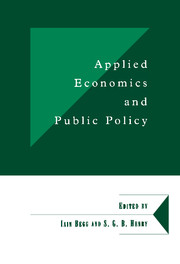Book contents
- Frontmatter
- Contents
- List of figures
- List of tables
- List of contributors
- Foreword
- 1 Introduction
- Part One MODELLING AND FORECASTING METHODS
- 2 Large-scale energy–environment–economy modelling of the European Union
- 3 Measurement errors and data estimation: the quantification of survey data
- 4 Social accounting matrices and applied general equilibrium models
- 5 The development of econometric methods at the DAE
- Part Two COMBINING DATA AND ANALYTIC TECHNIQUES
- Part Three USING MODELS TO GUIDE POLICY
- Bibliography
- Index
3 - Measurement errors and data estimation: the quantification of survey data
from Part One - MODELLING AND FORECASTING METHODS
Published online by Cambridge University Press: 06 July 2010
- Frontmatter
- Contents
- List of figures
- List of tables
- List of contributors
- Foreword
- 1 Introduction
- Part One MODELLING AND FORECASTING METHODS
- 2 Large-scale energy–environment–economy modelling of the European Union
- 3 Measurement errors and data estimation: the quantification of survey data
- 4 Social accounting matrices and applied general equilibrium models
- 5 The development of econometric methods at the DAE
- Part Two COMBINING DATA AND ANALYTIC TECHNIQUES
- Part Three USING MODELS TO GUIDE POLICY
- Bibliography
- Index
Summary
Introduction
The seminal paper by Stone, Champernowne and Meade (1942) analysed systematically the appropriate attribution of measurement error when estimating National Accounts data from disparate sources. Since its inception, the Department of Applied Economics (DAE) has been intimately concerned with problems of data estimation. More recently, an important component of the research programme at the DAE has been the estimation of expectations data and associated questions; see inter alia Lee (1994, 1995) and Pesaran (1984, 1987a). Research into the problem of estimating National Accounts data has also enjoyed a resurgence; see Weale (1992), Sefton and Weale (1995) and Smith, Weale and Satchell (1997).
This chapter conducts a re-examination and re-assessment of the use of macroeconomic survey data. Survey data on individual economic agents in conjunction with macroeconomic information offer the possibility of providing a rapid assessment of the current state of the economy and a tool for predicting the likely movement of the economy. Retrospective survey data may be available before the relevant macroeconomic data are published. Hence, together with other prior information, these data, if reliable, may be used to provide estimators for current but unavailable macroeconomic variables. Prospective survey data offer the possibility of the estimation of the expectations of macroeconomic variables. Therefore, these data, in conjunction with model-based forecasts, may prove useful as indicators of the likely future state of the economy.
The type of survey data typically available involves qualitative rather than quantitative responses.
- Type
- Chapter
- Information
- Applied Economics and Public Policy , pp. 41 - 58Publisher: Cambridge University PressPrint publication year: 1998
- 10
- Cited by

